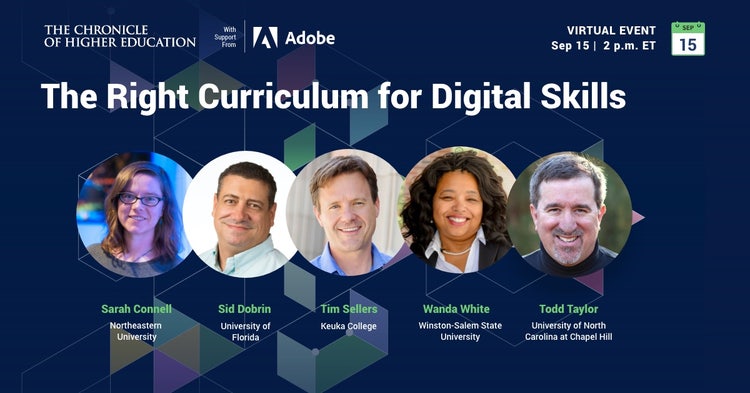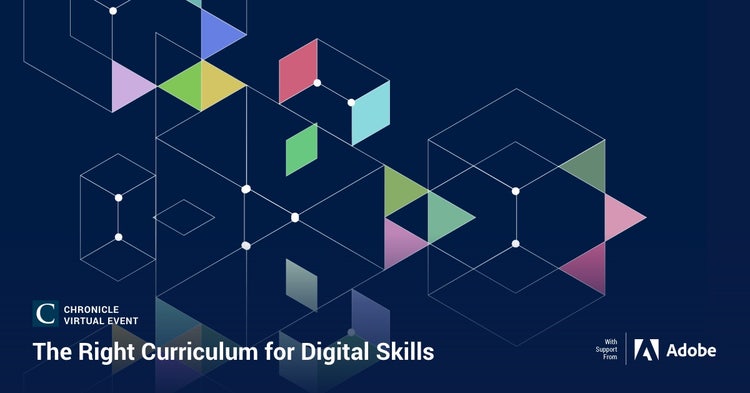A year in review: How colleges transformed their curricula in the COVID-19 era

Adobe recently hosted the final installment of a three-part webinar series with The Chronicle of Higher Education, which brought together faculty and administrators to discuss the biggest issues impacting higher education in 2021.
COVID-19 continues to transform the way faculty will teach for years to come. It illuminated the importance of engaging a new generation of students, adopting active learning practices and nurturing digital skills in any classroom environment. These efforts are incredibly important to us at Adobe and we continue to work closely with colleges around the world to integrate digital tools in the classroom to help achieve these goals.
Below are a few highlights from each of the webinar events, as we reflect on the advancements made in higher education over the past year and the fruitful discussions that took place:
Engaging a new generation of learners during a pandemic
During our first webinar event in March, “Engaging a New Generation of Learners,” we examined how higher education institutions leveraged technology and the evolution of remote learning environments.
Bryn Mawr College was tasked with determining how disruptive the transition to remote learning would be to its faculty and students. Gina Siesing, chief information officer and Constance A. Jones director of libraries at Bryn Mawr, stressed the importance of collaborating with peer institutions to augment core curricula through consortiums such as the Liberal Arts Collaborative for Digital Innovation (LACOL).
Bryn Mawr expanded its involvement in LACOL during the pandemic, allowing more students to enroll in online courses taught by peer institutions in subjects they were passionate about, especially in key areas such as data science, mathematics and lesser taught languages.
Panelists proactively highlighted the steps that other colleges can take to meet the needs of students upon resuming on-campus classes. Check out the full webinar recap here.

Lessons on active learning in the COVID-19 era
The second webinar event, “Active Learning for a Post-Pandemic World,” explored how remote education during the pandemic reshaped the role of the instructor and illustrated the importance of “active learning,” a method that promotes intrinsic, project and team-based collaboration, using technologies that drive engagement and build digital literacy.
In reflecting on the extent the pandemic has spurred pedagogical changes, Eric Mazur, Balkanski professor of Physics and Applied Physics at Harvard University, shared how asynchronous teaching and active learning practices that he employed led to the most successful year during his 40-year career.
He explained how these measures enabled students to access materials, ask questions and hone their skills at any time that worked for them, unlike traditional teaching that mandated simultaneous attendance at scheduled meetings or course lectures.
Mazur encouraged faculty to use digital modalities in their curricula moving forward and challenged those who rely only on more traditional, synchronous teaching practices. Instead, faculty should continue to explore what their future classrooms will look like and embrace a mix of traditional and new methods that meet the needs of their students. Read the full webinar recap here.

Creating the right curriculum that nurtures digital skills
The series concluded with “The Right Curriculum for Digital Skills” webinar, which examined the ways that colleges are strengthening digital literacy and competencies across diverse courses.
Wanda White, director for the Center for Innovative and Transformative Instruction at Winston-Salem State University, emphasized the benefits of workshops for faculty to explore how to incorporate digital tools into their own course assignments.
“We can't forget about faculty who may not have the enthusiasm that we have for digital literacy and digital learning,” White said. “I say to those faculty, ‘find one [tool] — you don't have to know them all — find one, learn it, love it, use it,’ and that's how we approach it.”
Similarly, Sarah Connell, assistant director of the NULab for Texts, Maps and Networks at Northeastern University, shared success stories from their Digital Integration Teaching Initiative, which partners with faculty from the institution’s College of Social Sciences and Humanities to embed digital proficiencies (e.g., tools, programs and best practices) into curricula to fit the unique needs of their students. For example, students in the German Department built professional portfolios written entirely in German while students in the English Department built collaborative, digital scholarly editions of Shakespeare using Adobe Creative Cloud.
“The thing that’s consistent is the transferability, the critical engagement, but almost everything else does need to be tailored to the goals of the specific classes and certainly the specific disciplines,” Connell said.
Faculty can increasingly demonstrate the value of their campuses by embracing digital tools that strengthen student engagement and meet their needs. As a parent of a college student, I am continually amazed by the transformations made in higher education over the course of the pandemic. However, there is much more work to be done to foster student success in an increasingly digital world.
For more information on how to integrate digital skills across disciplines and throughout curricula, please visit the Digital Literacy resources page.